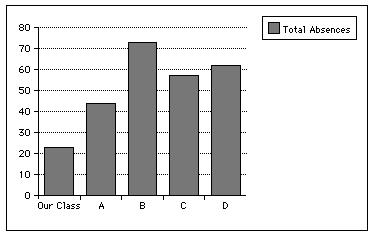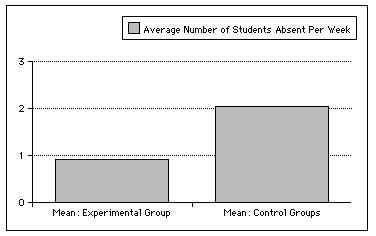
After reading Looking for Data in All the Right Places, by Alane Starko and Gina Schack, I wanted to incorporate authentic research skills into my curriculum. My students' previous research projects focused on library research: looking up information and rewriting it in their own words. I was determined to up the ante. By the end of the year, I wanted my students to be able to generate original questions that pertained to their own interests and pursuits, then to take those questions and find answers by designing research studies. They would learn about the different types of research, such as survey research, developmental research, experimental research, and they would learn the different methodologies for each type of research.
The next hurdle was to find a way to introduce the steps and skills to the whole group before setting them in search of the answers to their own questions. The concept of authentic research was unfamiliar to my students, and to assure quality projects, it was necessary that the students experience the procedure before attempting it on their own. I decided to involve the class in my own authentic research problem.
Like most teachers, I get frustrated when cold and flu season rolls around, with all of the absences and the never-ending cycle of make-up work. During the previous school year, I had started using Purell hand sanitizer on a regular basis, and I noticed that I took fewer sick days. I wondered if this would work on a larger scale. Here was an authentic research problem, which I then presented to my students. After discussing the various steps in finding an answer to a research problem, we designed our quasi-experimental study. The following is the procedure we followed:
1. First, we discussed the purpose of the experiment and the need for keeping our hands clean. Our independent variable (the one we controlled) was the use of hand sanitizer, such as Purell or Germ-X. The dependent variable was the number of absences. Our class was the experimental group; the other 5/6 grade classes were the control groups. This means that our class used hand sanitizer and the other 5/6 classes did not.
2. We defined what would be counted as an absence. Since we were monitoring the number of students who got sick, we needed to make sure all the classes counted illnesses in the same way. On a weekly basis, the classes counted the number of students who were absent due to illness. Even if a student was absent for more than one day in a week, it was still counted as one illness. In this way, we could count the effects of infection, not how long a student took to recover from that infection. We did not count students who came to school with colds. We decided this would be too difficult to monitor.
3. We asked the other 5/6 classes to keep track of the number of absences per week, using a special form to ensure all the teachers counted absences in the same way.
4. We purchased hand sanitizer and put it by the door. All students and teachers in Class 51 washed their hands with it whenever they entered the room, or after sneezing. The other 5/6 classes did not use hand sanitizer. They also did not know that they were part of our study.
5. Every two months, we collected the data from the other classes, looked at the data and analyzed it.
6. In January, we decided to ask one of the control groups to start using hand sanitizer to see if the absences in their classroom would be affected. We wanted to see if it was the hand sanitizer that made the difference, or if we just had a class of very healthy students. Control Group C was chosen, as they had the highest number of absences in the first months of the study. They were not told about the study. The teacher put hand sanitizer by the door and instructed the students to use it every time they entered the room. They were told it was to help stop the spread of germs so they could decrease the number of illnesses.
7. At the end of April, we analyzed all the data using a variety of measures, and made our conclusion.
It was the analysis portion of the project that allowed me to further develop my students' research skills. We graphed our monthly results and we learned about various statistical methods for analyzing data, including how to take into account the fact that one of our controls became an experimental group halfway through the year. After these calculations, we found that the mean number of absences per week for the classes not using hand sanitizer was 2.06. The mean number of absences per week for the classes using hand sanitizer was 0.92. We even did a t-test to see if the difference between our control groups and our experimental groups was significant. While I did not expect this level of sophistication in data analysis from my 5th and 6th graders in their own research projects, the experience was valuable.
After analyzing all the data, our next job was to come up with a conclusion for our study. We concluded that regular use of hand sanitizer decreases the number of absences due to illness. The final step in the process was to analyze the potential flaws in our experiment. We talked about the small size of our sample group and the fact that the other classes did not know that they were part of the study. The students had several ideas for redesigning the experiment to overcome these flaws.
Now we were ready to tackle individual research questions. In January, while our hand sanitizing project was still in progress, the students began thinking of individual research questions. They were initially tentative about the freedom of choice involved in finding a problem they were personally interested in studying. They also needed assistance in narrowing the problem to a single question so they could design a study to answer that question over a period of a few months. Most of my students chose questions that were best answered using survey research, so we spent time learning how to write pertinent and effective survey questions. While most questions reflected the students' own interests (cars, computers, ESP), one student did a detailed survey that examined the feelings of students at our school toward our school-wide discipline system and how those feelings change with age. The completed projects were displayed at our school's Interest Fair at the end of the year. The parents were impressed with the originality of the students' work and with the care and pride they took in their projects.
From the simple beginning of hoping for healthier students, a plan grew that turned my students into authentic researchers. Also important, because of the effectiveness of our hand-sanitizing routine, the students rarely missed school and I seldom had to reteach any lessons, including those about authentic research. Re-examine our statistics: our class had half the absences of the other 5th and 6th grade classes. So, even if you cannot include the teaching of authentic research in your classroom, put some hand sanitizer by your door and take advantage of our findings!

